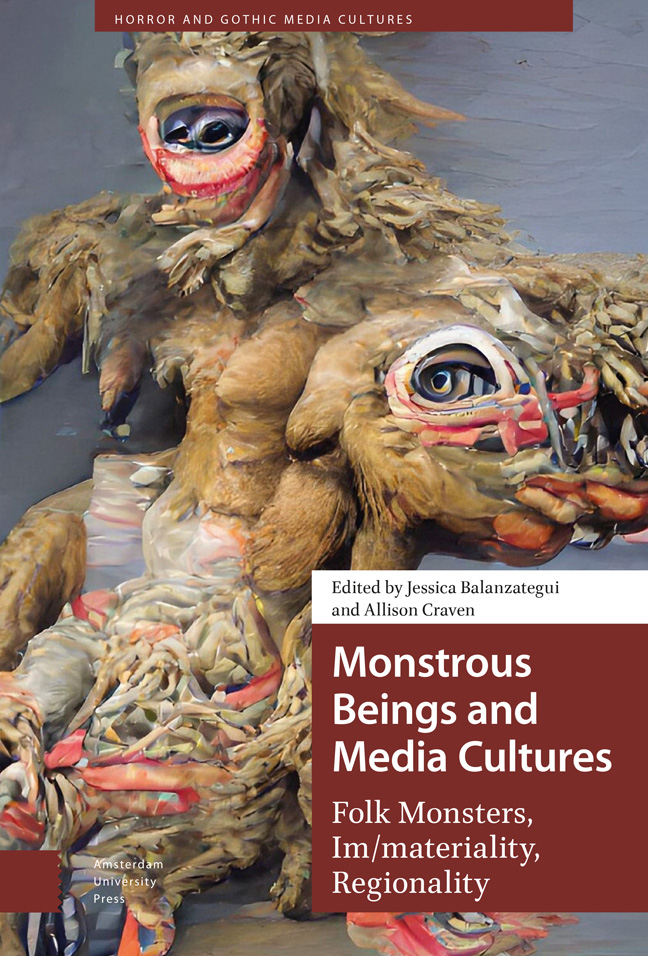Book contents
- Frontmatter
- Contents
- List of Figures
- Acknowledgements
- Introduction: Folk Monsters and Monstrous Media: The Im/materialties, Modalities, and Regionalities of Being(s) Monstrous
- 1 The Momo Challenge as Urban Legend: Child and Adult Digital Cultures and the Global Mediated Unconscious
- 2 “Every Imaginable Invention of the Devil”: Summoning the Monstrous in Eurocentric Conceptions of Voodoo
- 3 The Forest and the Trees: The “Woods” as Intersection between Documentary, Fairy Tale, and Internet Legend in Beware the Slenderman
- 4 Mark Duplass as Mumblegore Serial Killer: Fictional Vernacular Filmmaking in the Creep Series
- 5 Monsters in the Forest: “Little Red Riding Hood” Crimes and Ecologies of the Real and Fantastic
- 6 A Mother's Milk: Motherhood, Trauma, and Monstrous Children in Folk Horror
- 7 Documenting the Unheard: The Poetics of Listening and Empathy in The Family
- 8 Reimagining the Pontianak Myth in Malaysian Folk Horror: Flexible Tradition, Cinema, and Cultural Memory
- 9 An Uncommon Ancestor: Monstrous Emanations and Australian Tales of the Bunyip
- 10 The Folk Horror “Feeling”: Monstrous Modalities and the Critical Occult
- Works Cited
- Mediagraphy
- Index
3 - The Forest and the Trees: The “Woods” as Intersection between Documentary, Fairy Tale, and Internet Legend in Beware the Slenderman
Published online by Cambridge University Press: 17 February 2024
- Frontmatter
- Contents
- List of Figures
- Acknowledgements
- Introduction: Folk Monsters and Monstrous Media: The Im/materialties, Modalities, and Regionalities of Being(s) Monstrous
- 1 The Momo Challenge as Urban Legend: Child and Adult Digital Cultures and the Global Mediated Unconscious
- 2 “Every Imaginable Invention of the Devil”: Summoning the Monstrous in Eurocentric Conceptions of Voodoo
- 3 The Forest and the Trees: The “Woods” as Intersection between Documentary, Fairy Tale, and Internet Legend in Beware the Slenderman
- 4 Mark Duplass as Mumblegore Serial Killer: Fictional Vernacular Filmmaking in the Creep Series
- 5 Monsters in the Forest: “Little Red Riding Hood” Crimes and Ecologies of the Real and Fantastic
- 6 A Mother's Milk: Motherhood, Trauma, and Monstrous Children in Folk Horror
- 7 Documenting the Unheard: The Poetics of Listening and Empathy in The Family
- 8 Reimagining the Pontianak Myth in Malaysian Folk Horror: Flexible Tradition, Cinema, and Cultural Memory
- 9 An Uncommon Ancestor: Monstrous Emanations and Australian Tales of the Bunyip
- 10 The Folk Horror “Feeling”: Monstrous Modalities and the Critical Occult
- Works Cited
- Mediagraphy
- Index
Summary
Abstract
This chapter focuses on Irene Brodsky's documentary about the “Slenderman” internet legend, Beware the Slenderman (2016), which concerns the perpetrators of an attempted murder, devotees of Slenderman who believed their crime would make them his proxies. I argue that the documentary struggles between sensationalising and rationalising the crime and that, in attempting to explain the power of the Slenderman, Brodsky replicates the aesthetics of Slenderman vernacular media. The documentary also invokes a motif of the fairy-tale “woods” that comes to stand for the internet as an equivalent terrain of danger and menace. Brodsky's documentary is thus at odds with its objective: in trying to offer cohesion and closure to a troubling case, its narrative about an internet monster becomes monstrous and fantastical.
Keywords: Slenderman, folkloresque, fairy-tale woods, Creepypasta, hypermediacy, horror
The Slenderman is an internet urban legend, first created by Victor Surge in 2009 (Later 2014). Styled as a tall, faceless monster that stalks children at the edges of suburbia, he features in countless stories, games, films, artworks, and other media. Online creators contribute to the lore of the monster, using epistolary narratives to frame the Slenderman as a “real” monster in “archival” images, found footage films, and database storytelling, an online format Lev Manovich (2007) calls “anti-narrative” for its mutability (41). The storytelling style exemplifies the folkloresque, as Jeffrey A. Tolbert argues (2018), allowing Slenderman media to engage in “considerable slippage between the categories of ‘real’ and ‘fake’” folklore (99). For some adherents of the Slenderman legend, the folkloresque narrative incited a more disturbing slippage between reality and the limits of fandom. This slippage had deadly implications in 2014, when two twelve-year-old girls in Waukesha, Wisconsin, stabbed a third girl, claiming the attack was in the name of the Slenderman (Hanna and Ford 2014). The case attracted significant media attention and inspired the 2016 documentary Beware the Slenderman directed by Irene Taylor Brodsky. Beware the Slenderman presents an account of the attack, the subsequent court case, and the Slenderman phenomenon.
The Slenderman legend has been extensively discussed in terms of its genesis, circulation, and sources of its horror (Chess 2012; Balanzategui and Later 2017) and its folkloresque qualities (Tolbert 2018; Foster 2015). This chapter focuses on Brodsky's documentary, which has received little attention thus far.
- Type
- Chapter
- Information
- Monstrous Beings and Media CulturesFolk Monsters, Im/materiality, Regionality, pp. 81 - 102Publisher: Amsterdam University PressPrint publication year: 2023



